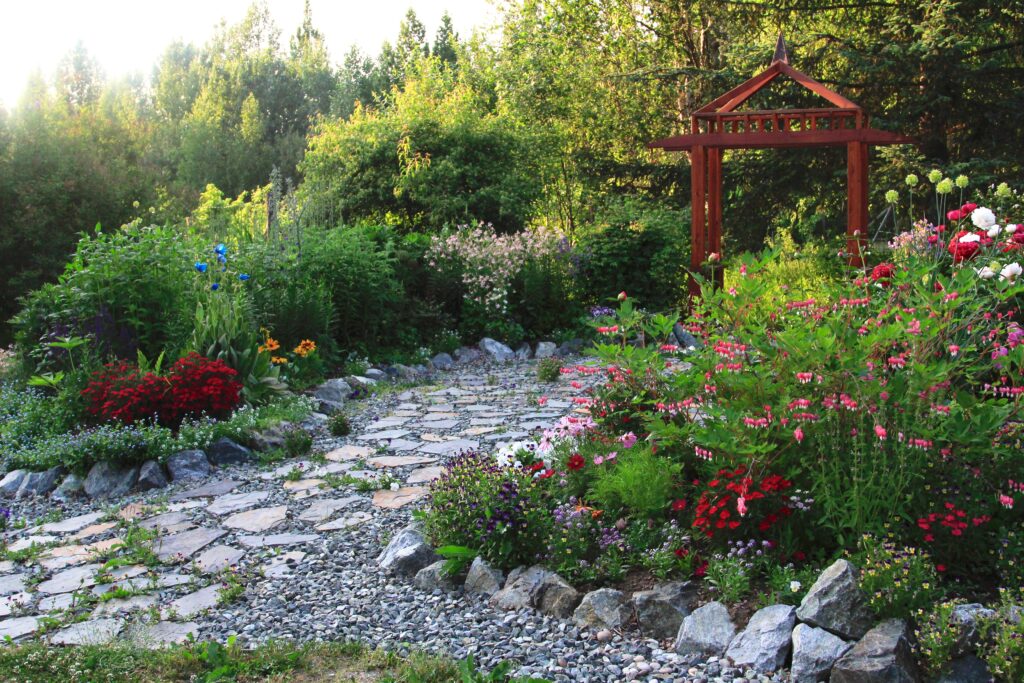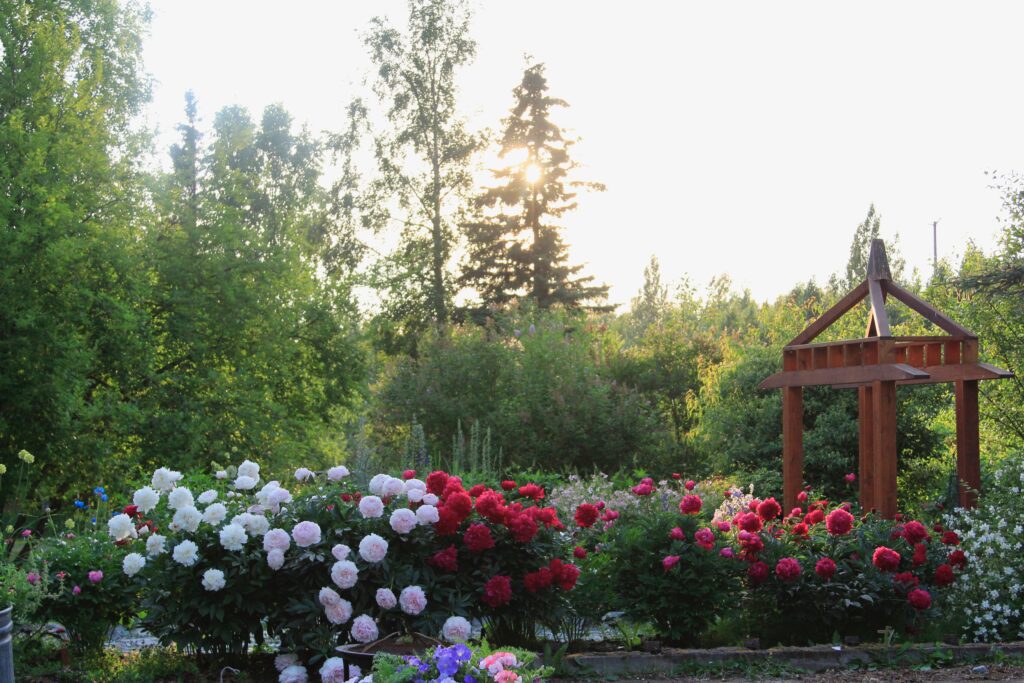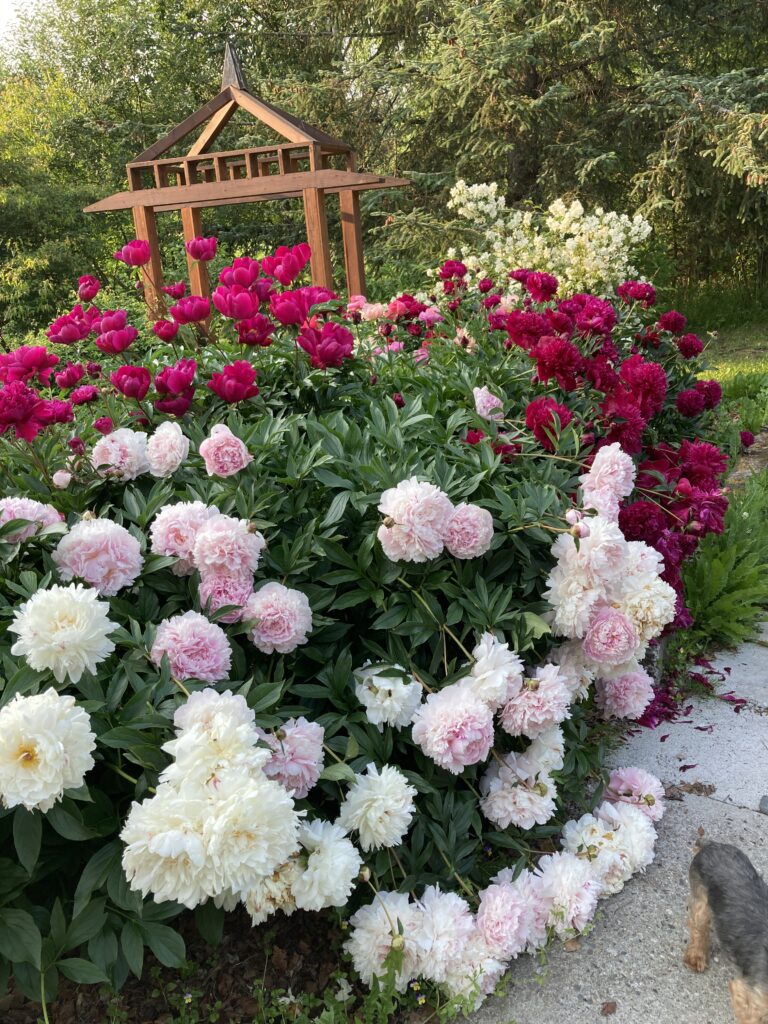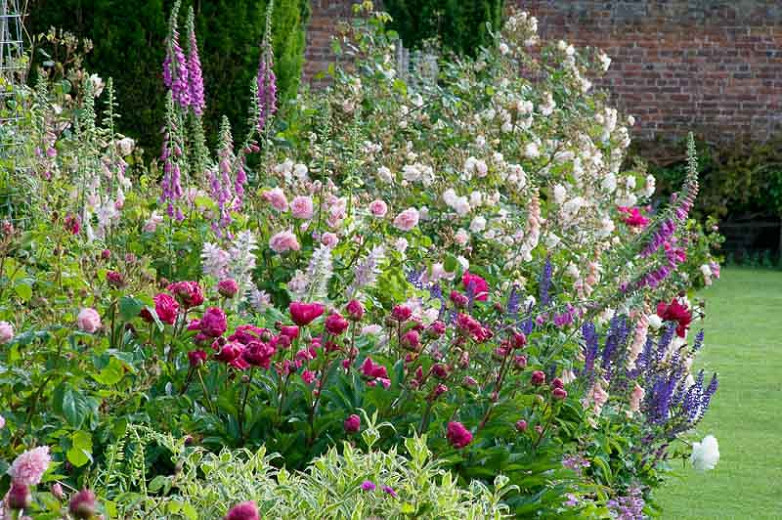A lovely home garden isn’t complete without the peony, which is Mother Nature’s crown jewel. Peonies are loved by everyone and will give you years of beauty in your garden and home. All it takes is some planning, work, and time.
The peony and rose together create the ultimate spring garden duo. With their sumptuous romantic blooms in shades of white pink, red and yellow, these classic flowers are cherished additions to any garden. When combined in a thoughtful design, peonies and roses can form the backbone of a beautiful landscape that blooms in late spring and delights the senses.
In this article, we’ll explore tips for planting peonies and roses together to create a cohesive garden plan. Follow these simple steps for mix and matching these botanical beauties.
Choosing the Right Peony and Rose Varieties
With hundreds of cultivars to select from, it’s important to choose complementary peonies and roses suited to your climate and growing goals.
Consider bloom time – Select early, mid and late season bloomers to extend color from spring through early summer. Pair early peonies like Paeonia lactiflora ‘Red Charm’ with roses like Rosa ‘A Shropshire Lad’ that bloom in late spring.
Match colors and forms – Blend peony and rose varieties in harmonious hues like soft pink or crimson reds. Combine double blooms with open, loose flowers for textural interest.
Include fragrant varieties – Opt for intensely scented roses and peonies to permeate the garden with fragrance,
Choose the right size – Scale larger peony varieties with taller climbing roses Smaller roses complement more compact peonies
Check hardiness – Ensure all selections are hardy in your planting zone. Most peonies thrive down to zone 3 while roses need zone 5 or warmer.
Planting Peonies and Roses for Success
Proper planting sets your peonies and roses up for healthy growth and maximum blooms. Follow these tips:
Provide full sun – Peonies and roses require a minimum of 6 hours of direct sunlight per day. Morning sun is essential.
Prepare the soil well – Amend planting beds with 2-3 inches of compost to improve drainage and nutrients. Most roses and peonies thrive in fertile, humus-rich soil.
Give peonies room – Space peonies 3-4 feet apart so they can develop their bushy form. Plant roses 2-3 feet apart depending on variety.
Plant peonies properly – Bury peony roots just 1-2 inches below the soil surface. Deeper planting prevents blooming. Add support rings to hold up heavy flowers.
Water thoroughly after planting – Water peonies and roses deeply after planting and whenever soil dries down 1 inch. Consistent moisture is key while plants establish.
Designing a Coordinated Layout
When designing your peony and rose garden, keep these layout tips in mind:
Group varieties together – Plant 3-7 plants of the same peony or rose cultivar together for cohesion. Repeat featured varieties throughout the garden.
Use roses as anchors – Place roses along fences, arbors or property lines to define the garden’s backbone and take advantage of vertical space.
Mass peonies towards the center or middle border – Peonies make excellent anchor plants along a mid-border. Place taller varieties towards the back.
Surround with companion plants – Fill in around peonies and roses with annuals, perennials and shrubs that harmonize in color, texture and bloom season.
Include evergreen structure – Incorporate evergreen shrubs, trees or hedges to provide architectural bones and year-round interest.
Combining Peonies and Roses in Garden Beds
Here are some tips for incorporating peonies and roses into key areas of your landscape:
Formal rose garden – Outline geometric beds with boxwood hedging and climbing roses on an arbor. Fill beds with bush roses underplanted with peonies.
Cottage garden – Mix peonies, heirloom roses, foxgloves, iris and other perennials together in a casual, informal display.
Herb garden– Tuck fragrant roses and peonies among herbs like sage, lavender and catmint.
Mixed border – Blend peonies, roses, ornamental grasses, hydrangea and other medium-sized shrubs along a fence or property line.
Containers – Plant compact patio rose varieties and dwarf peonies together in pots on entry ways, patios or in small courtyard gardens.
Caring for Peonies and Roses
While easy to grow once established, peonies and roses need proper care and maintenance to thrive:
Water 1-2 inches per week – Provide supplemental irrigation if rainfall is inadequate, especially while plants are young. Established plants need deep weekly soakings.
Apply organics annually – Topdress beds each spring with 2-3 inches of compost or well-rotted manure to maintain soil nutrition and structure.
Fertilize – Feed roses and peonies in early spring as growth begins and again 6-8 weeks later using a balanced fertilizer formulated for roses and flowers.
Prune – Remove spent rose blooms promptly by cutting just above a healthy outward facing leaf node to encourage reblooming. Cut back peony stems to ground level in fall once foliage has died back.
Protect from winter damage – In cold climates, mound compost or leaves over rose crowns to insulate. Leave peony stems over winter to help protect underground buds.
Stake for support– Set up stakes covered with soft material around peonies and climbing roses to keep heavy blooms upright and prevent damage.
Monitor for pests and diseases – Practice prevention by removing fallen leaves and petals. Promptly treat any fungal issues or infestations of Japanese beetles, aphids, etc.
Inspiring Peony and Rose Garden Design Ideas
Here are a few classic design ideas that combine roses and peonies beautifully:
Cottage Garden
Blend peonies, English and David Austin roses, foxgloves, catmint, lavender and salvia in soft pastel hues for a quintessential cottage garden brimming with charm.
White Garden
A serene and elegant theme is created by limiting the palette to white and green. Include white peonies, Alba roses, Astilbe, artemisia and Japanese painted fern.
Fragrance Garden
Focus on choosing the most fragrant peonies and rose varieties to create a soothing, relaxing and romantic private sanctuary filled with perfume.
Rose Arbor
Frame a focal point seating area with a classic rose-covered arbor. Underplant with peonies and iris in complementary colors of purple, yellow and soft pink.
Mixed Border
Incorporate peonies, shrub roses, hydrangea, daisies, ornamental grasses and other perennials along a fence line or property border. Allow informal mingling.
With thoughtful planning and care, a garden featuring peonies and roses promises to delight the senses each spring. Their lush, voluptuous flowers and intoxicating fragrance create a beautiful seasonal display to treasure.
Consider Your Garden Site
Peonies can be grown in USDA zones 2–8, but they need a steady winter chill to produce the most flowers. As a general rule, the daily low temperatures in the winter need to be less than 40° F for two months. This information is usually on the plant tag or the product listing, or you can do a quick search on Google to find it. Finding the types that have already been named as the best performers in your area is a good place to start.
You should plant your peony roots in soil that is rich in minerals, has a neutral pH (around 7), and a lot of humus (organic matter). Ensure the planting site has excellent drainage with enough organic matter to keep the soil well aerated. Like most plants that grow in the same conditions, peonies need to be watered regularly. However, they can’t stand water near their roots—as the experts say, “Peonies don’t like wet feet!”
Your peonies will need both good soil drainage and a lot of air flow around the plant because they are very likely to get fungal diseases. If you can help it, don’t plant peonies right up against a building or fence. Make sure there is plenty of space around the plant for air to flow. Keep in mind how large the peony plant will be when it is fully mature and plant accordingly.
Your peony garden will need sunlight at least 6-8 hours everyday, so consider your sunlight pattern. If you live in a hotter area, you should probably put your plants somewhere with some shade during the day. If you’re growing in a cooler climate, your peonies will thrive in ample sunshine. Since it’s mild during the day in Alaska (20–22 hours of daylight), our peonies are grown in full sun with no shade.

There are three types of peonies: itoh, herbaceous, and tree. Which one do you want in your garden? This article is about herbaceous types, which come in a fun range of flower shapes, such as single, semi-double, fully-double, bomb, anemone, and Japanese. People who garden may find it hard to decide which species to grow because there are so many to choose from.
Which peony you want to grow may depend on your budget and the color scheme you want to use. Some rare peonies can cost a lot. One thing we all agree on is that the bloom season should last as long as possible. A normal bloom time for herbaceous peonies last about three weeks. You can make the bloom season last up to six weeks longer in some places by picking early, mid, and late-blooming varieties.
Most of the time, double, semi-double, and bomb peony flowers are very heavy when they are fully opened. This is especially true when it rains and the flowers get soggy. When you give your peonies extra support, they are less likely to fall over or break, which keeps your garden looking beautiful.
Peony rings, which are metal rings with legs that are 12 to 18 inches in diameter, concrete reinforcing wire, which can be bent around the plant to make a cage, and ready-made tomato cages are all common ways to support peony plants. Around the plant, you can also use bamboo stakes or branches and weave twine in between the stakes to make a strong web. Once the plant grows into a full-grown plant, the support structures will usually be hidden by the canopy of leaves.

We really want our peonies to bloom all summer, but it’s not going to happen. Maybe that’s why we love their beauty and scent so much? To make sure our garden is beautiful all season, we plant longer-season companion plants with our peonies to add more wow to the garden when the peonies are done blooming.
Whatever plants you choose, be sure that they like the same growing conditions as your peonies. When adding to your garden, you should think about how much sun it gets, how much air flows through it, how well it drains, and what zones it can grow in.
If you want to add some color to your garden early in the season, spring bulbs like tulips, daffodils, hyacinths, crocuses, or even a group of Siberian or bearded iris are great choices. Always there, perennial plants are like gifts that keep on giving. They come back every year, often bigger and better than before. If you have empty spots in your garden, don’t forget that annuals are great for filling them in. They come in many shapes and sizes, from short, sweet alyssum to tall, spiked Madam Butterfly snap dragons. Make sure to plant companion plants or bulbs in groups of three or more so that they look strong and catch the eye.
No matter what plants you choose to “friend” your peonies, it’s best to include ones that give the garden a lot of different visual textures. To do this, use plants with spiky stems, broad or variegated leaves, and low ground cover that grow at different heights. This is also true for sculptures, ironwork, and creative garden art. A comfortable place to sit and enjoy your hard work will make the garden experience better.
Peony leaves are also pretty all summer, and in the fall, they often turn pretty shades of gold and bronze. Cut the plants back to the ground only in late fall, when they have lost all of their green color.

Most people who garden will cut off all of the buds on first-year peony plants before they form so that the plant can focus on growing roots. Over the years, peony plants will keep giving you a bigger and better show every season. This means that de-budding in the first few years can be seen as an investment in future blooms.
Putting fertilizer on the plant every spring will give it the food it needs to keep getting bigger and blooming more every year. An old saying about peonies says that the first year they sleep, the second year they creep, and the third year they leap!
As soon as your plants are fully grown, you can bring your garden flowers inside by cutting stems while the buds are still in a soft marshmallow-like stage. Your home will smell sweet with peonies.
Our free guide, How To Plant A Peony Cutting Garden, goes into more detail about how to plant peonies for cutting. You can find it on the right side of your browser window or under the “Press and Resources” tab.
Enjoy your artfully arranged perennial garden, and remember to take time to stop and smell the roses…or peonies.
-Written by the members of the Alaska Peony Cooperative
7 Peony Care Tips
How many peonies can you plant around a rose?
As peonies generally reach 3 by 3 feet at most, you can plant at least 3 to 4 peony seeds around your rose. Peonies are plants that are small in stature, and can be quite a good choice for small garden spaces. However, peonies and roses should be planted at least 15 to 20 cm apart, in order to allow precious space and breathability at mature sizes.
Can you plant roses and peonies together?
The good news for other romantic flower lovers, is that yes you can definitely plant roses and peonies together! Peonies and roses have similar watering, feeding, sunlight and even soil needs, which is why you can plant roses and peonies together in the first place. Peonies require slightly less watering, approximately 2.5 cm of water twice weekly.
How do you plant a peony in a hole?
Mix the amendments into the soil. Plant: Place your peony in the hole so that the buds are facing up and the top of the root ball is about 2 inches (5 cm) below the soil surface. Backfill the hole, ensuring that the soil doesn’t bury the root deeper than two in. (5 cm), or your plant may not bloom.
How do you plant a rose & peony?
Planting deep makes for a stronger plant, but will ultimately yield weaker flowers. Fill the hole and gently tap around with soil. Again, the roots are shallow, so don’t press hard! Water both your rose and peony thoroughly, until water starts leaking out of the drainage holes at the bottom of the container. There you have it, girls!
- The Ultimate Guide to Growing Strawberries in Raised Beds - August 8, 2025
- No-Dig Garden Beds: The Easiest Way to Grow a Beautiful Garden - August 6, 2025
- How to Protect and Preserve Wood for Raised Garden Beds - August 6, 2025

